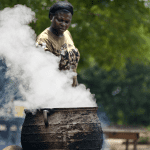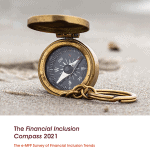A Tentative Recovery: Survey Data Shows Signs of Progress – and Warnings of Future Distress – Among Kenyan Farmers During COVID-19
Kenyan farmers faced a growing list of challenges in 2020 – from COVID-19 and locusts to (more recently) La Niña weather patterns that are threatening famine. These events have affected a range of stakeholders, but their impact on Kenyan farmers and the food systems they support is especially critical. It’s estimated that over 50 million people are in need of immediate food assistance in the Horn, East and Central Africa, according to Oxfam. As the COVID-19 pandemic carries into 2021, Kenyan farmers’ ability to weather this crisis is at the heart of the region’s recovery.
60 Decibels, a global social impact research firm, has collected data from thousands of Kenyan crop and livestock farmers, in an effort to bring their voices to the center of the conversation on supporting global food systems during COVID-19. As of December 2, we’d heard from 2,572 farmers using mobile-phone surveys, receiving responses from roughly 500 each month in June, July, August, September and October of last year. This work is funded by the Strengthening Impact Investing Markets in Agriculture program (SIIMA), through the UK Foreign, Commonwealth and Development Office’s Research and Evidence Division (FCDO).
Among the Kenyan farmers we surveyed, nearly nine in 10 report being financially worse-off since the start of the COVID-19 pandemic. While farmers are starting to see slight improvements, most are still far from a full recovery and are actually in danger of more severe, longer-term financial distress. The following timeline summarizes how Kenyan farmers’ financial wellbeing has changed since the early days of the pandemic.
A timeline towards recovery
June: At the beginning of our data collection, 17% of farmers reported a decrease in at least one income source compared to the same time last year. Nearly six out of 10 farmers told us they had made unplanned withdrawals from their savings, and 39% recently borrowed money to cover shortfalls in income due to the pandemic. Additionally, 18% of farmers reduced payments on their loans and 15% sold or pawned assets they own. The severity of this financial stress continued to increase through the summer.
July – August: From July to September, the percent of Kenyan farmers who indicated their financial wellbeing had gotten “much worse” since lockdown began increased from 31% to 54%, and nearly all farmers reported worsened financial wellbeing to some degree.
September: By September, when most farmers were purchasing inputs for the upcoming season, many of these critical indicators were at their peak: Farmers reported a worsening of financial wellbeing (54%), an increase in the loss of income sources (36%), and an increasing reliance on financial coping strategies (80% used savings, 40% borrowed money and 38% sold or pawned an asset) to make ends meet.
October: October brought slight improvements, with a decrease in the number of farmers doing “much worse” (40%), and fewer farmers indicating a loss of income sources (25%).
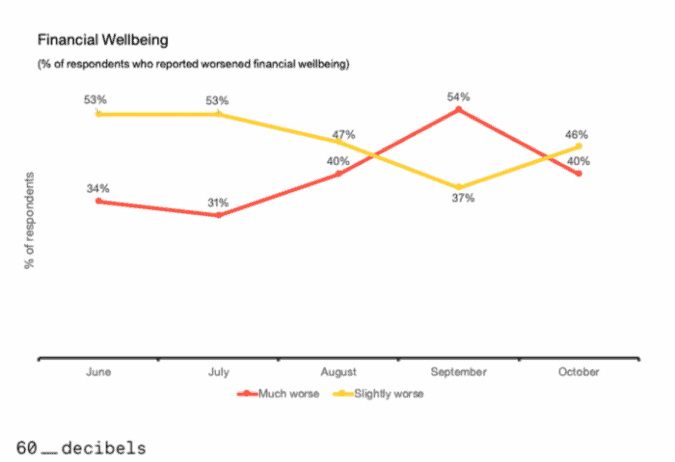
This early data indicates the downward spiral may have stabilized in October, as the use of savings and more extreme coping strategies to deal with financial burdens caused by the pandemic began to decline for the first time since data collection began (57% used savings, 33% borrowed money and 23% sold or pawned an asset). But this could be indicative of farmers running out of financial reserves, increasing the likelihood of future financial distress.
Data collection is still ongoing. The data collected from November and December will be critical to see if, as farmers deplete savings and salable assets, they become increasingly dependent on borrowing. If that’s the case, it could lead to a slower recovery after the end of the pandemic. And while the prices of farming inputs and food stabilized in the fall, returning to levels last seen in June, the prices farmers receive for crops continue to decrease. This could make it difficult for Kenyan farmers to maintain their livelihoods as earnings from the upcoming season are put at risk.
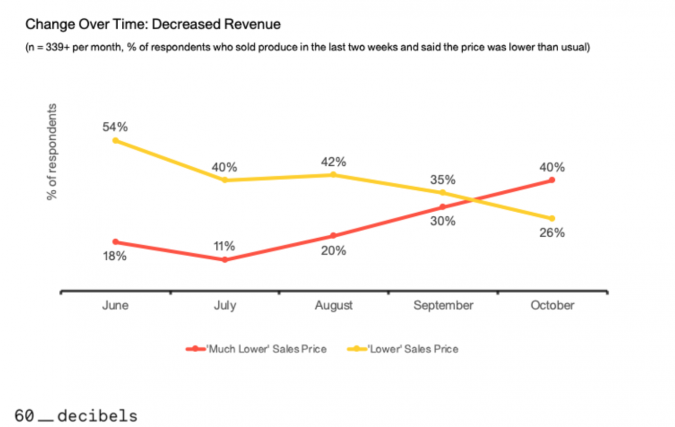
Yet even with these challenges, farmers in our survey expressed some optimism about the future. October’s data showed a slight increase in farmers’ confidence from the month before. And while numbers from October had not recovered to levels seen in July, a majority of farmers maintained confidence that they would be able to undertake normal farm activities in the next month. 60 Decibels will continue to track this, as the Kenyan government strengthens restrictions in response to a second wave of the virus.
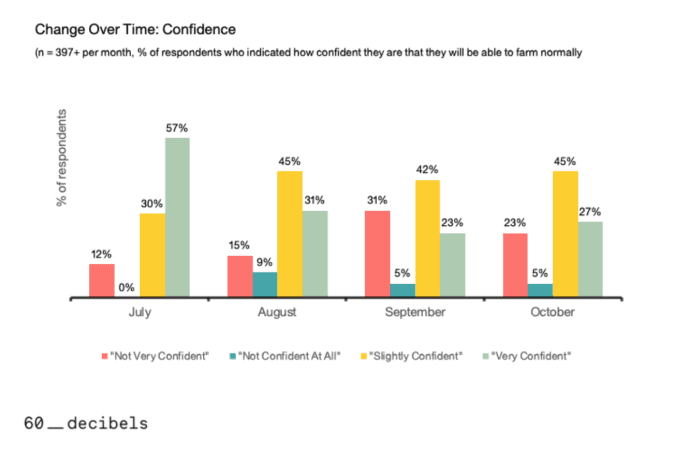
Four Calls to Action to Support Farmers During COVID-19
Several organizations have already taken action based on this data, shaping their response to meet the needs uncovered by these surveys. “Because of your data, we have made unprecedented efforts to get unconditional and conditional cash transfers to farmers,” said Leesa Shrader, Director of the AgriFin Accelerate Program at Mercy Corps.
For agriculture practitioners, donors and policymakers, the time to act is now. Based on our findings, 60 Decibels has issued the following four “calls-to-action” to stakeholders working to support farmers during the COVID-19 crisis.
- Cash is King: Liquidity remains a challenge for Kenyan farmers, as their financial situations worsen and their coping strategies are exhausted. Cash has remained farmers’ most-requested support measure month-over-month. Emergency financial loans could help farmers cope with their immediate financial needs, but to avoid over-indebtedness in the long-term, they need low-cost and flexible loans.
- Access to Affordable Inputs: While the prices of farming inputs such as fertilizer or feed appear to be stabilizing, farmers still face difficult financial choices in managing their budgets. And many indicate dwindling confidence in their future farming, particularly when they are in the earliest phases of the crop cycle, when harvest is still far away. Localized delivery of – and financial support for – high-quality inputs would help farming households cope with COVID-19.
- Expand Market Access: The majority of farmers we surveyed want to sell more, to help compensate for the disruption to markets. Digital market tools and platforms designed for smallholder farmers present a great opportunity to overcome the challenges and limitations created by the pandemic. Farmers are seeking connections to new buyers (67%), market information (66%) and transportation support (45%). Their priorities vary by gender, with women most often indicating they need improved access to new buyers (71%), and men most often asking for improved market information (66%).
- Lower the Barriers for Digital Solutions: Despite the potential for digital platforms to provide support to smallholder farmers, only 26% of the farmers we surveyed have increased their use of digital products during this pandemic. The top barriers include a lack of funds to purchase internet or airtime, network-related issues, lack of access to a device and poor trust in digital products. Women farmers are also less likely to use smart devices or the internet: 43% reported using a smartphone in the past month (compared to 57% of men), and 22% used the internet in the past month (compared to 30% of men).
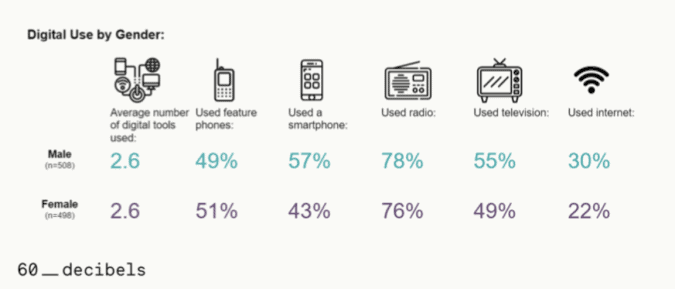
Female farmers were also more likely to cite the lack of access to a device or funds as their top barrier to using digital tools and platforms: 37% stated that access to a device is a barrier (compared to 23% of men), and 45% stated that they lacked funds to pay for digital services (compared to 33% of men). These gender differences in access and use should affect the approach practitioners, donors and policymakers take when using digital tools to support Kenyan farmers in their recovery.
60 Decibels will update this dashboard in January, with data collected in November and December. For more insights and analysis, you can access our public COVID-19 dashboard.
Venu Aggarwal is a Director and Kelsey Jarrett is a Senior Associate at 60 Decibels.
Photo courtesy of CIAT.
- Categories
- Agriculture, Coronavirus, Transportation
- Tags
- COVID-19, data, digital inclusion

